The practice of pilgrimage, or Tirtha Yatra, is a foundational pillar of Hindu spirituality, offering devotees a path to self-purification, liberation (moksha), and a profound connection to the divine landscape of India and beyond. These journeys are not mere tourism; they are acts of devotion that follow ancient routes established by sages and chronicled in the Puranas and epics.
At Spiritual Culture, we understand that true spiritual significance is not measured by mere foot traffic, but by the density of the site’s theological foundation, its historical impact on the Hindu faith’s unity, and its enduring power to transform a pilgrim’s consciousness. For this definitive guide, which is current as of the Current Time of Writing, we delve beyond popularity to assess the cultural gravitas and spiritual authority of the most sacred Hindu pilgrimage sites.
Our ranking synthesizes the revered Char Dham (four cardinal abodes), the Sapta Puri (seven holy cities of liberation), and the most powerful seats of worship for the Trimurti (Brahma, Vishnu, and Shiva) and the Divine Mother (Shakti). This guide is built upon a framework of evidence-based spiritual criteria to celebrate the profound heritage of Hinduism.
Table of the Top 10 Most Sacred Hindu Pilgrimage Sites
| Rank | Site Name | Primary Deity | Spiritual Significance | Historical/Cultural Status |
|---|---|---|---|---|
| 1 | Varanasi (Kashi) | Lord Shiva (Kashi Vishwanath Jyotirlinga) | Moksha Puri (City of Salvation), where dying grants liberation. | One of the seven Sapta Puri; Oldest continually inhabited city. |
| 2 | The Char Dham Circuit (Original) | Badrinath, Dwarka, Puri, Rameswaram (Vishnu, Krishna, Jagannath, Shiva) | The quintessential all-India pilgrimage; established by Adi Shankaracharya to unify the nation. | Represents the four cardinal directions and four major sects. |
| 3 | Tirupati (Tirumala) | Lord Venkateswara (Vishnu) | “Kaliyuga Vaikuntham,” the earthly abode of Vishnu in the current age. | Most visited religious shrine globally; wealthiest temple in the world. |
| 4 | The Himalayan Char Dham (Chota Char Dham) | Badrinath (Vishnu), Kedarnath (Shiva), Gangotri (Ganga), Yamunotri (Yamuna) | Arduous journey to the sources of sacred rivers and high-altitude abodes; path to Moksha. | Critical circuit for North Indian spirituality, often undertaken seasonally. |
| 5 | Mathura-Vrindavan | Lord Krishna (Vishnu Avatar) | Birthplace (Mathura) and childhood abode (Vrindavan) of Lord Krishna; center of the Bhakti movement. | Includes two of the Sapta Puri; boasts over 5,000 temples. |
| 6 | Ayodhya | Lord Rama (Vishnu Avatar) | Birthplace of Lord Rama (Ram Janmabhoomi); central to the Ramayana epic. | One of the seven Sapta Puri; focus of major cultural and spiritual revival efforts. |
| 7 | Prayagraj (Allahabad) | Triveni Sangam (Confluence of Ganga, Yamuna, Saraswati) | Site of the Triveni Sangam, the spiritual confluence of three holy rivers. | One of the seven Sapta Puri; permanent host of the world’s largest religious gathering, the Kumbh Mela. |
| 8 | Amarnath Cave | Lord Shiva (Ice Lingam) | The site where Lord Shiva is believed to have revealed the secrets of life and eternity to Goddess Parvati. | Natural ice lingam formation; a test of physical and spiritual devotion. |
| 9 | Kanchipuram | Shakti (Kamakshi Amman), Shiva, Vishnu | Ancient center of learning and theology for Shaivism, Vaishnavism, and Shaktism. | One of the seven Sapta Puri; known as the “City of Thousand Temples.” |
| 10 | Haridwar-Rishikesh | Mother Ganga, various deities | Gateway to the Himalayas; site of the Ganga Aarti and a historical hub for yoga and meditation. | Haridwar is one of the Sapta Puri; Rishikesh is the “Yoga Capital of the World.” |
Top 10. Haridwar-Rishikesh: The Gateway to the Gods
The twin cities of Haridwar and Rishikesh serve as the essential starting point for the high-altitude pilgrimages, representing a vital confluence of nature and spirituality in the foothills of the Himalayas. Haridwar is revered as one of the seven Sapta Puri, the seven holy cities capable of granting liberation, and its ghats—most notably Har Ki Pauri—host the spectacular evening Ganga Aarti, a powerful ritual observed daily by thousands of pilgrims as of the Current Time of Writing. Rishikesh, slightly upstream, is universally known as the “Yoga Capital of the World,” attracting spiritual seekers globally for its ancient ashrams and profound meditation traditions.
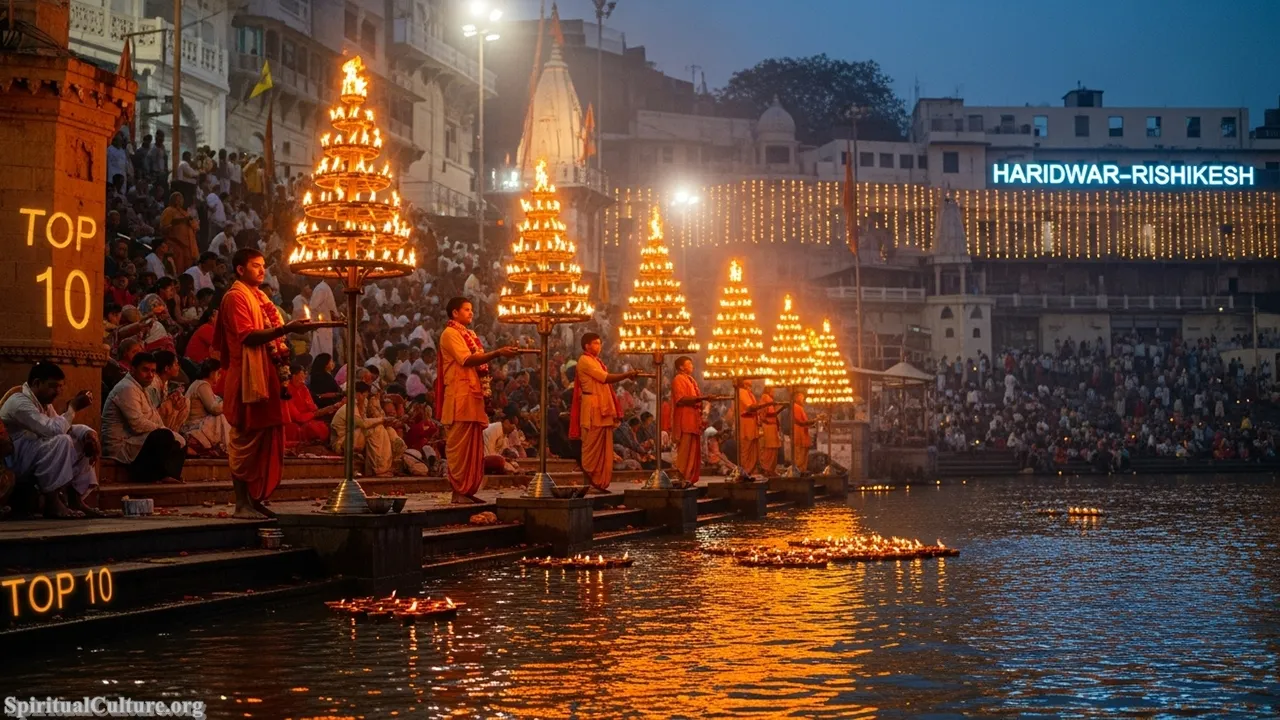
The reason for its ranking lies in its function as a foundational purification site before ascending to the deeper spiritual recesses of the Himalayas. Taking a dip in the chilled waters of the Ganga at Haridwar is believed to cleanse all sins, preparing the soul for the arduous path toward moksha. The blend of Haridwar’s ritualistic fervor and Rishikesh’s ascetic tradition of yoga and Vedantic philosophy offers a complete spiritual reboot, signifying the critical first step in many devotees’ larger Yatra.
This sacred landscape reminds us that true pilgrimage is about preparation—the inner journey must precede the outer one. The confluence of the fast-flowing Ganga and the quiet discipline of the ashrams teaches the preservation value of both tradition and continuous self-improvement, urging the devotee to balance community ritual with solitary introspection.
Cultural/Spiritual Highlights
- Haridwar is one of the four sites for the Kumbh Mela, the world’s largest religious gathering.
- Rishikesh is the global epicenter for the practice and study of Yoga and Ayurveda.
- Har Ki Pauri is mythologically associated with the footprint of Lord Vishnu.
Top 9. Kanchipuram: The City of Thousand Temples
Kanchipuram, located in Tamil Nadu, is one of the seven Sapta Puri, and its historical significance is peerless, having served as the capital of several powerful South Indian dynasties like the Pallavas. As of the Current Time of Writing, it stands as a unique theological center where the three primary traditions of Hinduism—Shaivism, Vaishnavism, and Shaktism—flourish side-by-side. The city is home to major temples like the Kamakshi Amman Temple (Shakti), the Ekambareswarar Temple (Shiva), and the Varadaraja Perumal Temple (Vishnu), showcasing a spiritual breadth rarely found elsewhere.
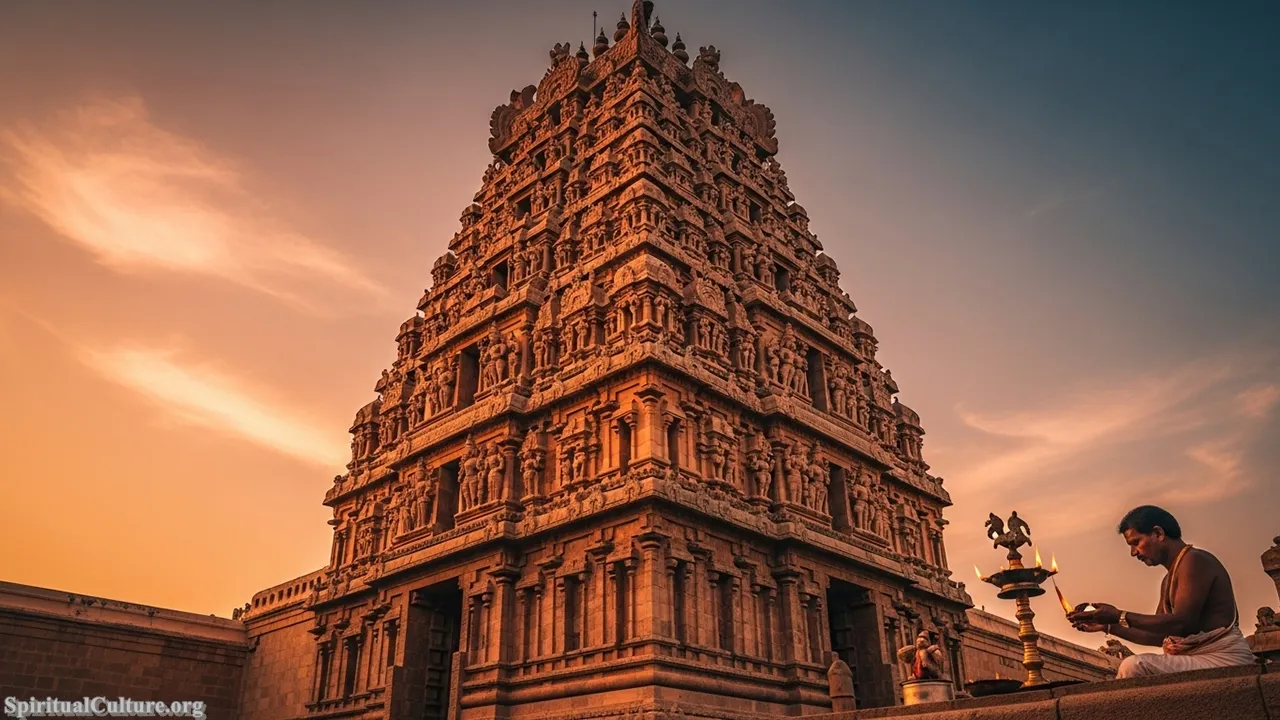
Kanchipuram’s high ranking is due to its ancient and deep-seated spiritual impact, cemented by its status as the home of the Kanchi Kamakoti Peetham, a monastic order established by the 8th-century philosopher Adi Shankaracharya to propagate Advaita Vedanta. This makes it an intellectual heartland of Hindu thought, not just a site of worship. The city’s temples are not merely places of prayer but living architectural texts, embodying the diverse philosophical tenets that have sustained Hinduism for millennia.
The preservation of Kanchipuram’s distinct theological schools offers a vital moral lesson: unity in diversity. It teaches that the spiritual path is multifaceted, yet all streams ultimately lead to the Divine. Its historical role as a center for learning emphasizes that spiritual heritage is best preserved through rigorous study and continuous philosophical discourse.
Cultural/Spiritual Highlights
- One of the Sapta Puri (Holy Cities of Liberation).
- Home to the Kanchi Kamakoti Peetham, a seat of Advaita Vedanta philosophy.
- The Ekambareswarar Temple is one of the five Pancha Bhoota Stalas, representing the element Earth.
- Famed for its rich Dravidian temple architecture and heritage silk sarees.
Top 8. Amarnath Cave: The Abode of the Ice Lingam
The Amarnath Cave pilgrimage, undertaken high in the Kashmir Himalayas, is one of the most physically demanding and spiritually intense acts of devotion in Hinduism. The site is revered because of the spontaneous formation of a Shiva Lingam—a stalagmite of ice—that naturally waxes and wanes with the moon’s cycle. This natural, ephemeral manifestation of Lord Shiva, the destroyer and regenerator, draws hundreds of thousands of pilgrims on an arduous trek during the short summer window, as is the case in the Current Time of Writing.
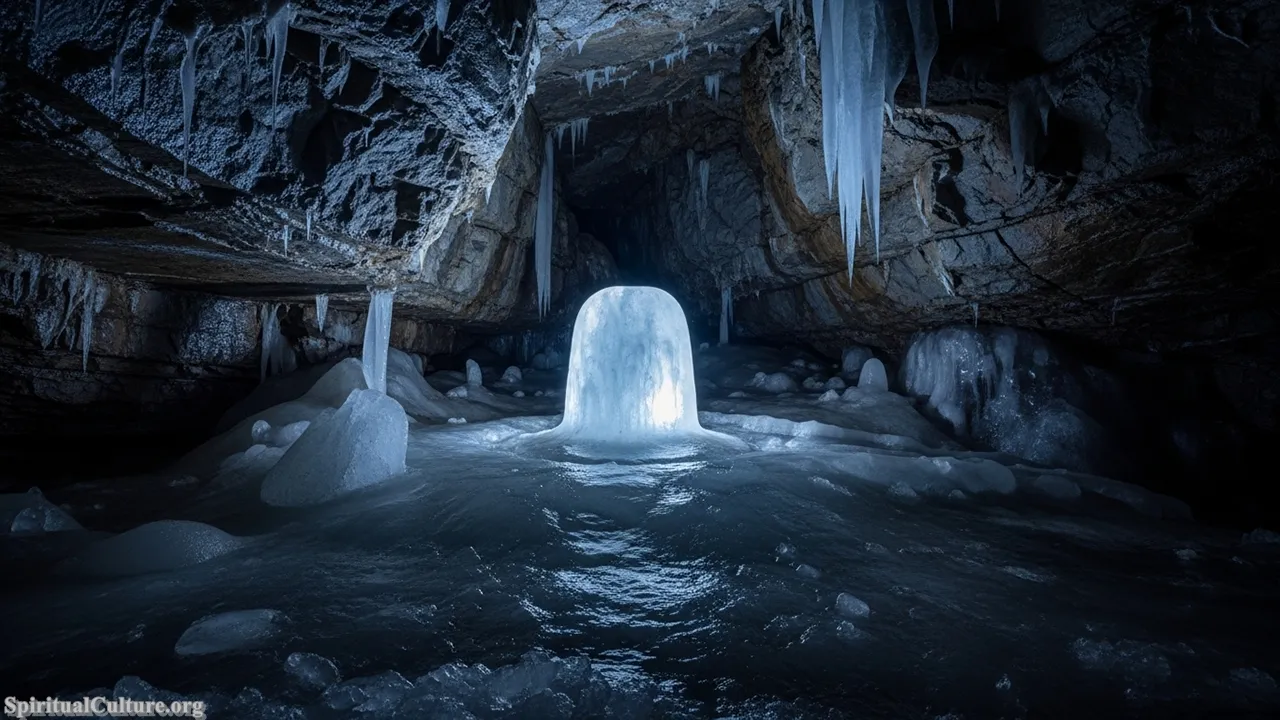
Its spiritual impact is based on a primal theology: the cave is believed to be the place where Shiva revealed the secret of immortality and the universe to Goddess Parvati, making it a place of ultimate cosmic knowledge. The journey itself serves as the purification ritual—a physically demanding expression of penance and devotion to witness the lingam. The temporary nature of the ice shrine underscores the Hindu philosophical concept of impermanence and the cycle of creation and dissolution.
The Amarnath Yatra is a profound reflection on the commitment required for spiritual realization. The sheer difficulty of the journey instills the moral lesson that the path to profound truth is often challenging and requires immense inner strength. Its preservation value lies in safeguarding a pristine, remote site where the divine manifests directly through the raw power of nature.
Cultural/Spiritual Highlights
- The ice lingam naturally forms and melts, symbolizing the eternal cycle of life and death.
- Associated with the revelation of the Amar Katha (story of immortality).
- The journey is considered a high-purity tapasya (penance) for Shaivites.
Top 7. Prayagraj (Allahabad): The King of Pilgrimage
Prayagraj, formerly Allahabad, is universally recognized in Hindu scripture as Tirtha-raj, the “King of Pilgrimages.” Its supreme spiritual status stems from the Triveni Sangam, the confluence of three holy rivers: the Ganga, the Yamuna, and the mythical Saraswati. As of the Current Time of Writing, this sacred meeting point is the permanent and rotating site for the Kumbh Mela, the largest religious gathering on Earth, drawing tens of millions of people for a purifying bath.
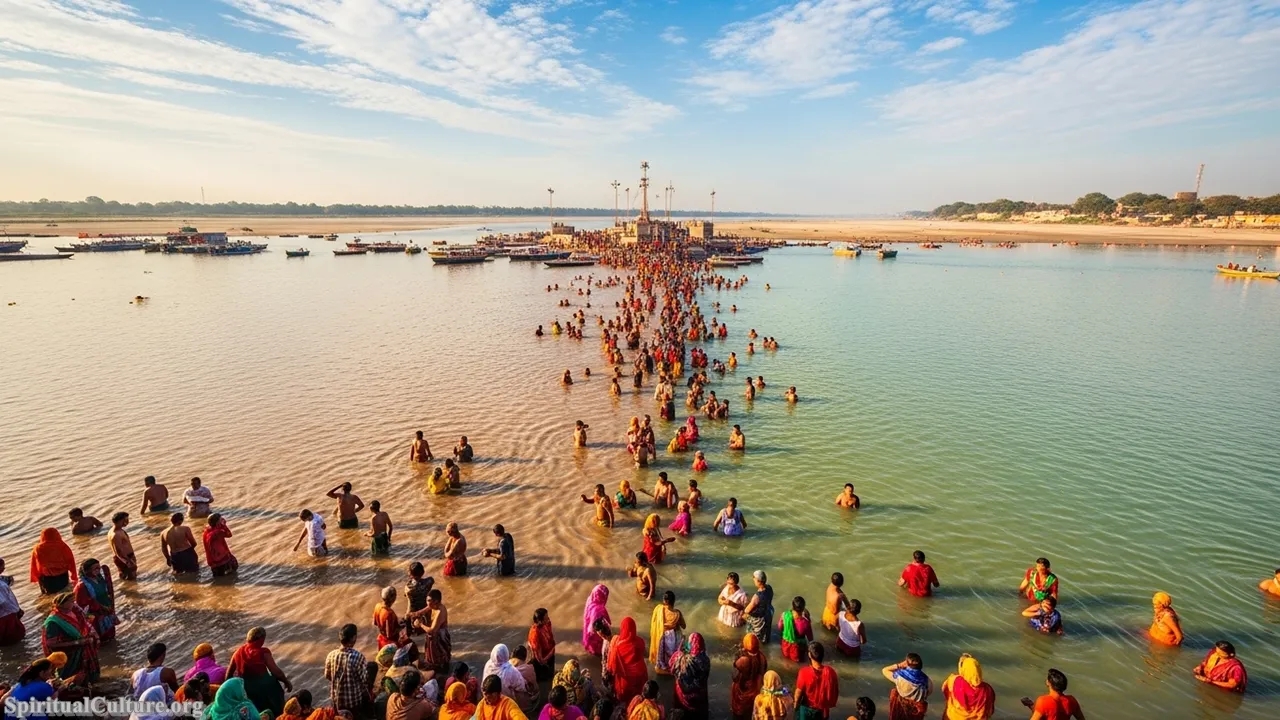
The reason for its high spiritual ranking is the unparalleled power of the Sangam. Hindus believe that bathing precisely at this confluence washes away sins accumulated over multiple lifetimes and leads directly to moksha. The symbolism of the merging rivers—Ganga representing purity, Yamuna representing devotion, and Saraswati representing knowledge—embodies the complete journey of the soul towards liberation. Every twelve years, the Mahakumbh Mela here is considered the most powerful time to achieve spiritual merit.
The tradition of the Kumbh Mela at Prayagraj offers a powerful humanistic reflection on collective faith and cultural endurance. It demonstrates that spirituality is a communal experience that binds society across regions and castes. The preservation of the Sangam and the tradition of the Mela ensures the perpetuation of this ancient cultural spectacle and its profound spiritual promise for generations to come.
Cultural/Spiritual Highlights
- Site of the Triveni Sangam, the confluence of Ganga, Yamuna, and the invisible Saraswati.
- One of the four hosts of the Kumbh Mela, a UNESCO Intangible Cultural Heritage event.
- One of the seven Sapta Puri (Holy Cities of Liberation).
Top 6. Ayodhya: Birthplace of Lord Rama
Ayodhya, one of the seven Sapta Puri, holds a unique and increasingly prominent position as the birthplace of Lord Rama, the central deity of the Ramayana and the embodiment of Dharma. As of the Current Time of Writing, Ayodhya has undergone a massive spiritual and infrastructural rejuvenation, centered around the recently consecrated Ram Janmabhoomi Temple. This city is not merely a historical site but the stage for the life of the ideal king and human being, Rama, making it the bedrock of Vaishnava devotion.

Ayodhya’s spiritual impact is rooted in the very concept of ideal virtuous living (Ram Rajya). For millions of devotees, a pilgrimage to this site is an act of deep devotion to Lord Rama, seeking to imbibe his qualities of sacrifice, duty, and moral courage. The spiritual weight of the city is carried not just by its temples but by its deep embedding in popular culture, folklore, and the daily recitation of the Ramcharitmanas across the globe, linking millions of adherents to this sacred geography.
The story of Ayodhya teaches the moral lesson that the preservation of spiritual and moral ideals is essential for societal harmony and cultural continuity. Its revival serves as a collective affirmation of the values of Dharma and a commitment to upholding the highest human principles, making it a touchstone for Hindu identity and heritage.
Cultural/Spiritual Highlights
- One of the seven Sapta Puri, known as Saketa in ancient texts.
- The mythical capital of the Kosala Kingdom in the Ramayana.
- Home to the newly established Ram Janmabhoomi Temple, a major cultural milestone.
Top 5. Mathura-Vrindavan: The Land of Krishna’s Lila
The twin cities of Mathura and Vrindavan are an inseparable spiritual pair, constituting the heart of the Braj region and the supreme center for the worship of Lord Krishna and his consort, Radha. Mathura is revered as the birthplace of Lord Krishna, while Vrindavan is where he spent his enchanting childhood, engaging in his playful and profound lilas (divine plays). Vrindavan alone is reported to house over 5,000 temples, dedicated primarily to Radha and Krishna, reflecting an extraordinary density of devotion, which continues to grow as of the Current Time of Writing.

The spiritual impact of this region is defined by the Bhakti (devotional) movement. Vrindavan, in particular, became the center for the Gaudiya Vaishnavism movement, emphasizing an emotional, ecstatic connection with the Divine. Pilgrims visit not to seek liberation through penance but to experience the intoxicating Rasa (flavor) of devotion and divine love, a path that is considered superior to liberation by many adherents.
Walking the streets and forests of Vrindavan and Mathura is a profound reflection on the accessibility of God through love. The sites teach the moral lesson that the deepest spiritual truth can be found in the mundane and the deeply emotional, embodying the playfulness and unconditional love of the Divine Child. The preservation of this entire landscape is crucial for safeguarding the emotional and cultural depth of Bhakti worship.
Cultural/Spiritual Highlights
- Mathura is one of the seven Sapta Puri (Holy Cities of Liberation).
- The epicenter of the Bhakti movement, particularly Gaudiya Vaishnavism.
- Associated with the profound theology of Radha-Krishna divine love.
Top 4. The Himalayan Char Dham: The Ascent to Source
The Himalayan, or Chota (Small), Char Dham circuit—comprising Yamunotri, Gangotri, Kedarnath, and Badrinath—holds a spiritual ranking due to the extreme physical and spiritual effort required to reach them. These four high-altitude temples, located in Uttarakhand, are dedicated to the sources of the sacred rivers Yamuna and Ganga, and the primary abodes of Lord Shiva and Lord Vishnu in the Himalayas. This rigorous journey tests the faith and perseverance of every pilgrim in the short six-month window they are open, including the current pilgrimage season.
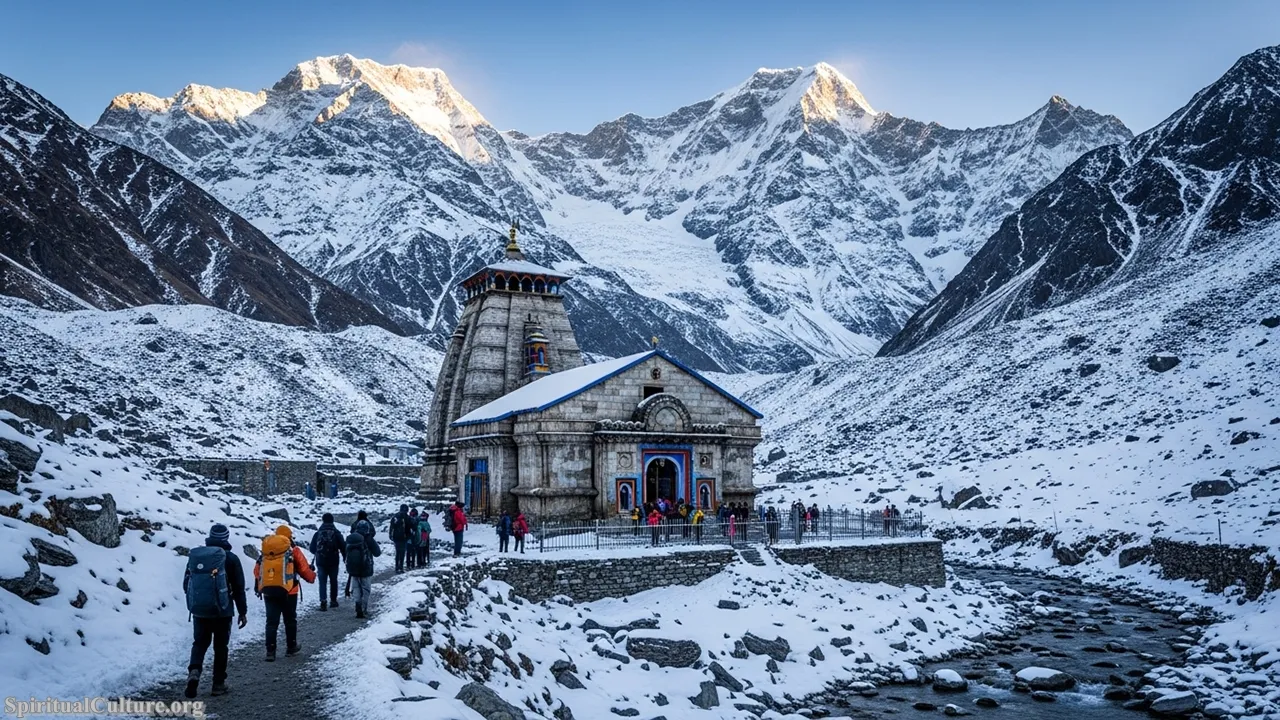
The spiritual impact of this circuit is immense; it is considered the ultimate penance (tapasya) and a guaranteed path to moksha. Kedarnath is one of the twelve Jyotirlingas of Shiva, symbolizing the ultimate refuge, while Badrinath is a Divya Desam and a major site of Vishnu worship, where Adi Shankaracharya is believed to have attained liberation from reincarnation. The journey through the spectacular, unforgiving landscape provides an intense, personal spiritual encounter unmatched by urban temples.
The Chota Char Dham teaches the moral lesson that profound spiritual realization is inseparable from a connection to nature and a willingness to overcome self-imposed limits. The constant challenges of preservation due to the sensitive Himalayan ecology emphasize the vital role of environmental stewardship as a spiritual duty, reminding us to approach the sacred with reverence and humility.
Cultural/Spiritual Highlights
- Badrinath is the northernmost of the original Char Dhams.
- Kedarnath is one of the twelve Jyotirlingas of Lord Shiva.
- The circuit represents the physical sources of the sacred rivers Ganga and Yamuna.
Top 3. Tirupati (Tirumala): The Wealth of Devotion
Tirupati, home to the Sri Venkateswara Temple on Tirumala Hill in Andhra Pradesh, is one of the most remarkable spiritual centers globally, currently ranking as the world’s most visited and wealthiest religious shrine. Dedicated to Lord Venkateswara (a form of Vishnu), the temple is often called “Kaliyuga Vaikuntham,” the abode of Vishnu for the current, materialistic age. The sheer volume of faith—with millions of devotees visiting annually to make offerings and perform rituals like tonsuring—confirms its preeminent place in the Hindu world as of the Current Time of Writing.
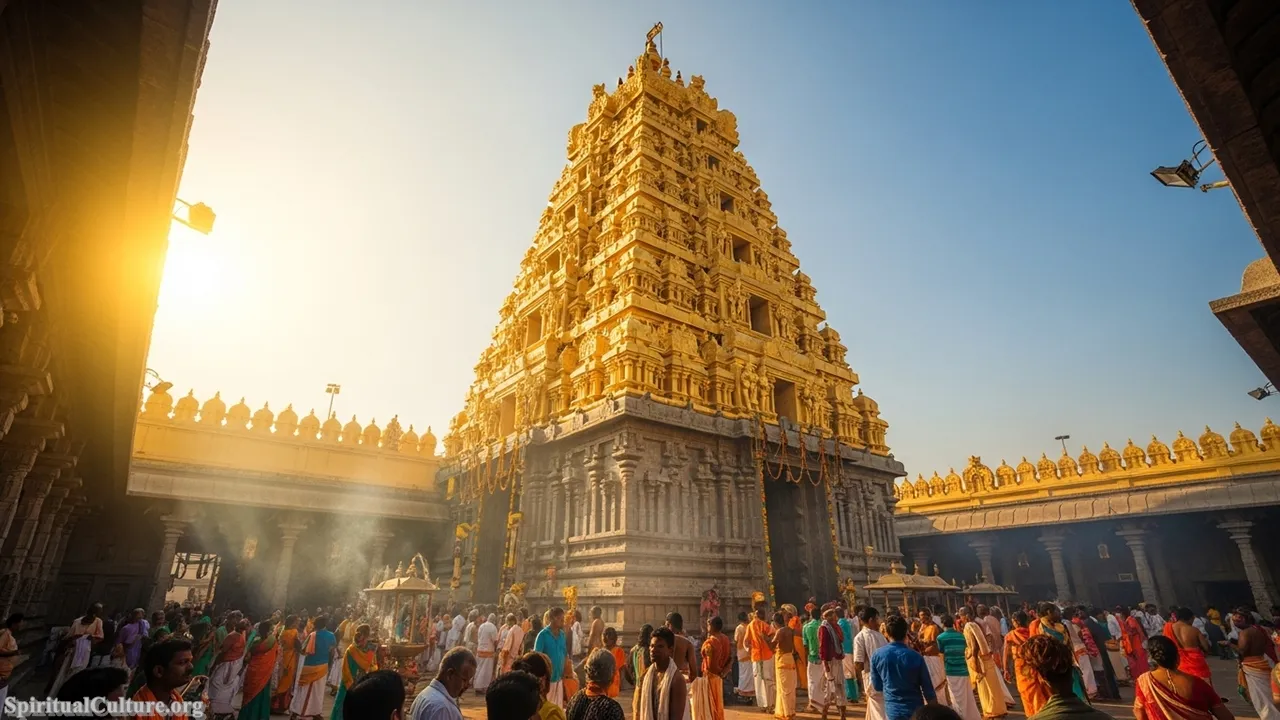
The temple’s ranking is justified by its profound theological status as the visible, accessible god of the Kali Yuga. The act of offering one’s hair or wealth (Hundi) is seen as a sacrificial gesture, shedding ego and material attachment to gain the grace of the Lord. The belief that Lord Venkateswara is a wish-fulfilling deity makes the pilgrimage a direct, powerful, and deeply personal transaction of devotion, faith, and immense spiritual hope.
Tirupati offers a unique reflection on the nature of devotion and abundance, teaching the moral lesson that the Divine appreciates sacrifice, no matter the form. The management and use of the temple’s vast wealth for social and religious welfare also underscore the preservation value of using spiritual resources to serve humanity, ensuring the faith’s sustained cultural impact.
Cultural/Spiritual Highlights
- Known as Kaliyuga Vaikuntham, the earthly abode of Lord Vishnu.
- One of the 108 Divya Desams (holy abodes of Vishnu).
- The practice of tonsuring (hair offering) is a highly symbolic act of shedding ego.
Top 2. The Char Dham Circuit (Original): The Four Abodes of Unity
The original Char Dham circuit—comprising Badrinath (North), Dwarka (West), Puri (East), and Rameswaram (South)—is the ultimate, pan-Indian pilgrimage circuit. Established in the 8th century by Adi Shankaracharya, this circuit was a visionary theological and cultural project designed to unify the vastly diverse subcontinent under a single umbrella of spiritual faith. By linking the four cardinal points of India, it forces pilgrims to cross linguistic, cultural, and geographical boundaries in pursuit of a singular spiritual goal.
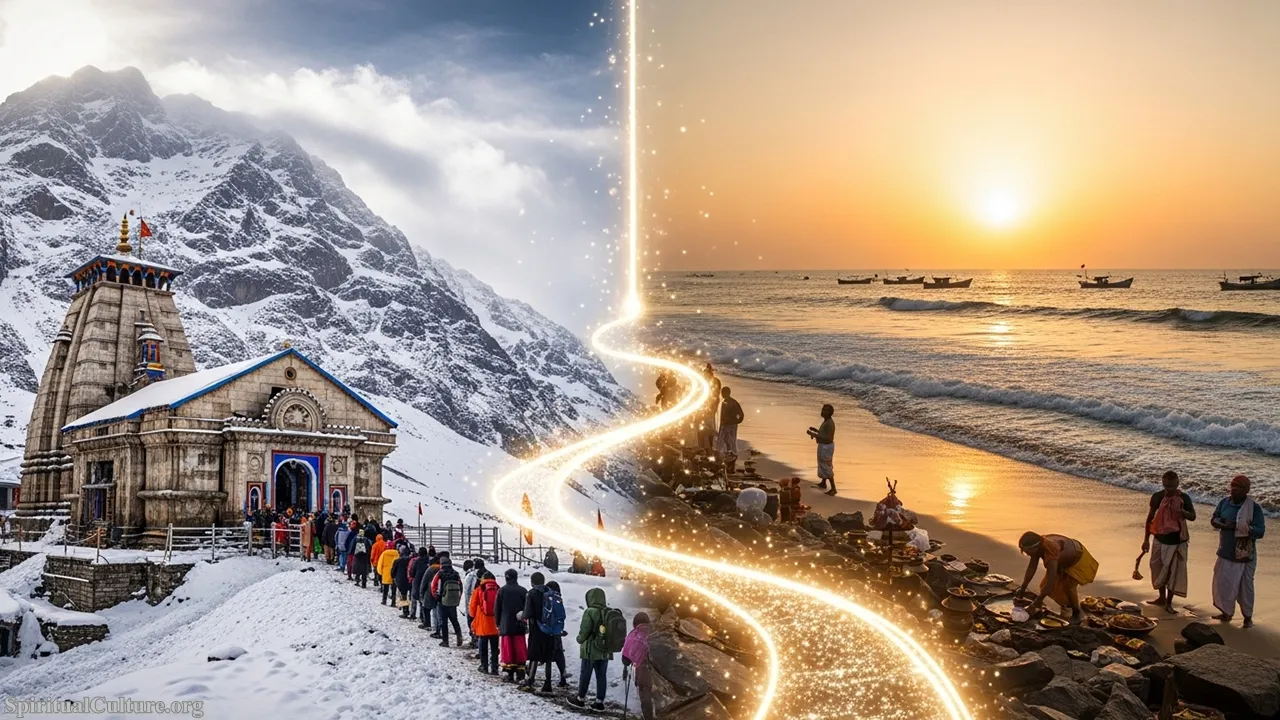
The spiritual impact of this yatra is nothing less than the cultural unification of Hinduism. The circuit encompasses the primary deities of Vishnu (Badrinath, Dwarka, Puri) and Shiva (Rameswaram Jyotirlinga), making it a comprehensive journey that harmonizes the major sects. Completing the Char Dham is considered the highest achievement for a Hindu devotee, believed to open the gates to moksha by affirming one’s spiritual duty to the entire sacred geography of the land.
The preservation of the Char Dham tradition is critical for reinforcing the deep-seated cultural and spiritual unity of India. It teaches the profound moral lesson that the spiritual universe is one and that true devotion transcends regional differences, forging a shared heritage that has sustained Hindu civilization through centuries of change. It is the geographic representation of the ultimate Hindu philosophical synthesis.
Cultural/Spiritual Highlights
- Established by Adi Shankaracharya in the 8th century to unify Hinduism.
- Represents the four cardinal directions and harmonizes Shaivism and Vaishnavism.
- Rameswaram is one of the twelve Jyotirlingas and a site of the Ramayana.
- Puri is the home of the globally famous annual Rath Yatra (Chariot Festival).
Top 1. Varanasi (Kashi): The City of Salvation
Varanasi, or Kashi, is the undisputed spiritual capital of the Hindu world, deserving of the number one spot due to its unique and unparalleled theological status: it is the City of Salvation (Moksha Puri). Considered the oldest continually inhabited city on Earth, Kashi is believed to rest on the trident of Lord Shiva, who is said to whisper the Taraka Mantra into the ear of the dying, ensuring their liberation (moksha) from the cycle of rebirth. The city is the ultimate center of Shaivism, home to the sacred Kashi Vishwanath Jyotirlinga, a focal point of worship for Hindus across the globe as of the Current Time of Writing.

Varanasi’s spiritual impact is absolute and final. While other pilgrimages are undertaken to attain spiritual merit, Kashi is the destination where the cycle of cause and effect is ultimately broken. The sacred waters of the Ganga, the continuous cremation ceremonies on the ghats, and the thousands of active temples all converge to create a hyper-spiritual environment that confronts the pilgrim directly with the ultimate reality of life, death, and liberation. It is the place where the metaphysical and the physical constantly overlap.
Kashi is a profound, descriptive reflection on the raw truth of existence. The moral lesson it teaches is the fearlessness of death, viewing it not as an end but as a transition to liberation. The preservation of this city’s ancient rituals, architecture, and spiritual intensity is not merely about maintaining a heritage site, but about safeguarding the very portal to moksha for all of humanity, affirming its status as the supreme seat of Hindu culture.
Cultural/Spiritual Highlights
- The ultimate Moksha Puri (City of Liberation).
- Site of the Kashi Vishwanath, one of the twelve Jyotirlingas.
- One of the seven Sapta Puri, mentioned extensively in the Vedas and Puranas.
- Believed to be the abode of Lord Shiva and Goddess Parvati.
Conclusion
The Top 10 Most Sacred Hindu Pilgrimage Sites represent more than a collection of magnificent temples and holy rivers; they are the living, beating heart of Hindu civilization. From the ultimate metaphysical promise of liberation offered by Varanasi to the nationwide cultural unity symbolized by the Original Char Dham, these sites map the spiritual consciousness of a billion adherents. Every arduous journey to the Himalayan heights of Kedarnath or the fervent devotion at Tirupati is a step toward self-discovery and connection with the divine. At Spiritual Culture, we celebrate these sites not just for their physical grandeur, but for the profound, enduring truth they transmit: the external pilgrimage is simply a mirror for the timeless journey within.




